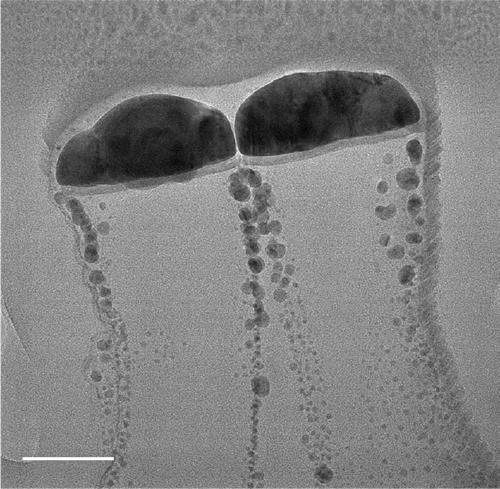A kind of preparation method of surface-enhanced Raman substrate
A surface-enhanced Raman and substrate technology, applied in the field of nanomaterials, can solve problems such as large limitations, weakening of the enhanced electric field, and fluctuations in the size of the gap, and achieve the effect of a wide range of applications
- Summary
- Abstract
- Description
- Claims
- Application Information
AI Technical Summary
Problems solved by technology
Method used
Image
Examples
Embodiment 1
[0046] A method for preparing a surface-enhanced Raman substrate, comprising the following steps:
[0047] Step 1: On a glass substrate, a nano-columnar array structure is obtained by nanoimprinting. The material of the column is a flexible polymer, and the size of the column is 650 nanometers in height and 60 nanometers in diameter;
[0048] Step 2: Deposit silver on the nano-pillar array structure obtained in step 1 to obtain a metal nano-finger array structure. Considering that the excitation wavelength of the Raman spectrometer selected in the experiment is 532 nm, the thickness of silver and gold is controlled to be 40 nm. ;
[0049] Step 3: Deposit a 1 nm tetrahedral carbon film on the metal nanofinger array structure obtained in step 2, and the film thickness is controlled by the deposition rate and deposition time. In this example, a filtered cathodic vacuum arc method was used to deposit tetrahedral carbon films.
[0050] The filtered cathodic vacuum arc method used...
Embodiment 2
[0060] The difference from the first embodiment is that in this example, a quartz substrate with weak fluorescent signal is selected in step 1, and silver is deposited on the nano-pillar array structure in step 2.
[0061] For the silver-containing surface-enhanced Raman substrate generated in this example, a bimolecular system was used to verify that the silver nanofinger closed array structure has a single-molecule detection level.
[0062] In this example, the internationally recognized bimolecular detection system is used to evaluate whether the surface-enhanced Raman substrate can realize Raman measurement at the single-molecule level (Phys. Chem. Chem. Phys. 13, 4500–4506 (2011)). Here, rhodamine molecule (R6G) and crystal violet (CV) molecule are selected as bimolecules, mainly because the two molecules have obvious differences in Raman characteristic peaks. First, prepare a mixed solution of R6G and CV molecules with the same concentration, here the main consideration ...
PUM
| Property | Measurement | Unit |
|---|---|---|
| thickness | aaaaa | aaaaa |
| diameter | aaaaa | aaaaa |
Abstract
Description
Claims
Application Information
 Login to View More
Login to View More - R&D
- Intellectual Property
- Life Sciences
- Materials
- Tech Scout
- Unparalleled Data Quality
- Higher Quality Content
- 60% Fewer Hallucinations
Browse by: Latest US Patents, China's latest patents, Technical Efficacy Thesaurus, Application Domain, Technology Topic, Popular Technical Reports.
© 2025 PatSnap. All rights reserved.Legal|Privacy policy|Modern Slavery Act Transparency Statement|Sitemap|About US| Contact US: help@patsnap.com



